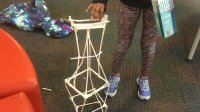Quick and Inexpensive Design Challenges
Encouraging upper elementary and middle school students to collaborate in solving a problem helps cement science learning.
Your content has been saved!
Go to My Saved Content.Design challenges typically present students with a problem to solve using limited materials. A good design challenge has many possible solutions, encourages creative thinking and teamwork, and teaches valuable content in an engaging and hands-on manner. Some challenges require expensive materials and many days or weeks to complete. When you have a limited budget and just a day or two of class time to spare, design challenges like the following ones can get students creating, cooperating, and thinking.
1. Alka-Seltzer Rocket to Mars Challenge
Problem: Your rocket must launch from the ground into a bucket on the roof of the school.
Materials: Alka-Seltzer tablets, film canisters (I purchased 30 canisters on Amazon for $9), containers for water, a large bucket, a roof or high place like the top of a playground.
Alka-Seltzer and water create carbon dioxide bubbles, and when sealed together inside an old film canister, they create a “rocket” that pops high up into the air.
I give students the target of an orange bucket (representing the planet Mars) placed on the roof of our school to encourage maximum height and accuracy with their rockets. Each group gets six Alka-Seltzer tablets, a film canister, and a container of water. They are encouraged to try different amounts of water and Alka-Seltzer until they achieve maximum height.
Students put some water in the canister, drop in some Alka-Seltzer, quickly seal the top, then put it down and step back. After about 10 seconds, the pressure causes the canister to fly into the air, and the students estimate the height using marks on the side of our building for reference. They record data and make changes until they run out of Alka-Seltzer or put their canister in the bucket. They quickly learn that too much water weighs the rocket down and creates less room for pressure to build.
Just half an Alka-Seltzer tablet and a tiny amount of water allows for 7 or 8 meters of height. Students also learn about the challenges of landing a rocket accurately, and about how to adjust hypotheses and gradually improve performance.
2. Kool-Aid Challenge
Problem: Your team must create a new and delicious flavor of Kool-Aid that wows your classmates.
Materials: A variety of Kool-Aid flavor powders, graduated cylinders or liquid measurement containers, paper cups, water.
I get parent permissions and check on student allergies before beginning any activity that involves food or drink. First, I mix five or six different flavors of Kool-Aid in 2-liter containers. I typically choose a variety of flavors, including one or two unusual ones like lemon-lime and strawberry-kiwi. The teams are challenged to make 1 liter of their new creation by combining multiple flavors.
They measure out each flavor using graduated cylinders until their concoction totals 1,000 ml. Students create names for their flavors and signs to advertise them. Each student samples the other new flavors using a paper cup, then ranks them.
We tally the votes and declare a winner of our Kool-Aid new-flavor competition. Students learn about metric volume and use creativity and collaboration to come up with their best solutions to the problem.
3. Solar Oven Challenge
Problem: Your team must create a solar-powered oven that warms a marshmallow.
Materials: Cardboard boxes, aluminum foil, plastic wrap, ziplock bags, black construction paper, marshmallows, thermometers.
We do this activity after studying the properties of light. Sometimes I provide a variety of cardboard boxes, or some years I ask the local pizzeria to donate a batch of pizza boxes.
Students first draw their designs individually, then decide on a group design. Many groups reflect light into their oven using aluminum foil, and they line the bottom with black paper to absorb light and turn it into heat.
The best-performing designs typically use plastic wrap (plastic laminating material also works well) to trap the heat inside their oven using the greenhouse effect. We place the ovens outside in the morning, with a thermometer in each box and one marshmallow per group member. We check temperatures and eat the marshmallows near the end of the school day to maximize heating time. Obviously, a bright and hot day works best.
Students learn how concepts like reflection, refraction, and absorption can work together to create heat.
4. Straw Tower Challenge
Problem: Create the tallest tower using only straws and masking tape in 45 minutes.
Materials: 40 straws per group, 3 feet of masking tape per group.
Just like with the solar ovens, I ask students to create individual designs (we use the Procreate app on iPads) and then agree on a group design. Students may tape straws to the floor but to no other objects in the room. Often, the most successful designs start with a sturdy base, like a triangular or rectangular prism, then build up in gradually smaller shapes as the tower gets higher.
Many times, a group will start building upward quickly and will pull ahead, only to lose stability and see their tower droop or fall over as the time limit is reached.
Students learn engineering and geometric skills, adapt their designs as conditions change, and think creatively in three dimensions in this challenge.
